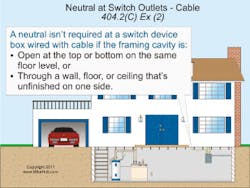All questions and answers are based on the 2011 NEC.
Q. When is the neutral conductor required to be provided at the switch location for lighting loads?
A. Switches controlling line-to-neutral lighting loads must have a neutral provided at the switch location [404.2(C)] unless either of the conditions of the following exception is met.
Exception: The neutral conductor isn’t required at the switch location if:
- The conductors for switches enter the device box through a raceway that has sufficient cross-sectional area to accommodate a neutral conductor.
- Cable assemblies for switches enter the box through a framing cavity that’s open at the top or bottom on the same floor level, or through a wall, floor, or ceiling that’s unfinished on one side, as shown in the Figure.
Note: The purpose of the neutral conductor is to complete a circuit path for electronic lighting control devices.
Q. Is there any Code requirement for a raceway that crosses a structural expansion joint?
A. Yes. A listed expansion/deflection fitting or other approved means must be used where a raceway crosses a structural joint intended for expansion, contraction, or deflection [300.4(H)].
Q. Where are tamper-resistant receptacles required by the Code?
A. All nonlocking type 15A and 20A, 125V receptacles in the following areas of a dwelling unit [210.52] must be listed as tamper-resistant [406.12].
- Wall space — 210.52(A)
- Small-appliance circuit — 210.52(B)
- Countertop space — 210.52(C)
- Bathroom area — 210.52(D)
- Outdoors — 210.52(E)
- Laundry area — 210.52(F)
- Garage and outbuildings — 210.52(G)
- Hallways — 210.52(H)
Exception: Receptacles in the following locations aren’t required to be tamper-resistant:
- Receptacles located more than 5½ ft above the floor.
- Receptacles that are part of a luminaire or appliance.
- A receptacle located within dedicated space for an appliance that in normal use isn’t easily moved from one place to another.
- Nongrounding receptacles used for replacements as permitted in 406.4(D)(2)(a).
Q. What are the NEC requirements for the installation of receptacles in a dwelling unit foyer?
A. Foyers in a dwelling unit that aren’t part of a hallway [210.52(H)] having an area greater than 60 sq ft must have a receptacle located on any wall space 3 ft or more in width and unbroken by doorways, floor to ceiling windows, and similar openings [210.52(I)].
Q. What are the GFCI requirements for dwelling units?
A. Ground-fault circuit interrupter protection for personnel must be provided as required in 210.8(A) through (C). The ground-fault circuit-interrupter device must be installed at a readily accessible location. In addition, GFCI protection is required for all 15A and 20A, 125V receptacles located in dwelling units in the following locations [210.8(A)]:
- Bathroom area. GFCI protection is required for all 15A and 20A, 125V receptacles in the bathroom area of a dwelling unit.
- Garages and accessory buildings. GFCI protection is required for all 15A and 20A, 125V receptacles in garages, and in grade-level portions of accessory buildings used for storage or work areas of a dwelling unit.
- Outdoors. All 15A and 20A, 125V receptacles located outdoors of dwelling units, including receptacles installed under the eaves of roofs, must be GFCI protected.
Exception: GFCI protection isn’t required for a receptacle that’s supplied by a branch circuit dedicated to fixed electric snow-melting or deicing or pipeline and vessel heating equipment, if the receptacle isn’t readily accessible and the equipment or receptacle has ground-fault protection of equipment (GFPE) [426.28 and 427.22].
- Crawl spaces. All 15A and 20A, 125V receptacles installed in crawl spaces at or below grade of a dwelling unit must be GFCI protected.
- Unfinished basements. GFCI protection is required for all 15A and 20A, 125V receptacles located in the unfinished portion of a basement not intended as a habitable room and limited to storage and work areas.
Exception: A receptacle supplying only a permanently installed fire alarm or burglar alarm system isn’t required to be GFCI protected [760.41(B) and 760.121(B)].
- Kitchen countertop surfaces. GFCI protection is required for all 15A and 20A, 125V receptacles that serve countertop surfaces in a dwelling unit.
- Sinks. For other than kitchen sinks, GFCI protection is required for all 15A and 20A, 125V receptacles located within an arc measurement of 6 ft from the outside edge of the sink.
- Boathouses. GFCI protection is required for all 15A and 20A, 125V receptacles located in a dwelling unit boathouse.
Q. What are the GFCI requirements for other than dwelling units?
A. GFCI protection is required for all 15A and 20A, 125V receptacles installed in the following commercial / industrial locations [210.8(B)]:
- Bathrooms. All 15A and 20A, 125V receptacles installed in commercial or industrial bathrooms must be GFCI protected.
- Kitchens. All 15A and 20A, 125V receptacles installed in an area with a sink and permanent facilities for food preparation and cooking [Art. 100], even those that don’t supply the countertop surface, must be GFCI protected.
- Rooftops. All 15A and 20A, 125V receptacles installed on rooftops must be GFCI protected.
- Outdoors. All 15A and 20A, 125V receptacles installed outdoors must be GFCI protected.
Exception 1 to (3) and (4): GFCI protection isn’t required for a receptacle that’s supplied by a branch circuit dedicated to fixed electric snow-melting or deicing or pipeline and vessel heating equipment, if the receptacle isn’t readily accessible and the equipment or receptacle has ground-fault protection of equipment (GFPE) [426.28 and 427.22].
- Sinks. All 15A and 20A, 125V receptacles installed within 6 ft of the outside edge of a sink must be GFCI protected.
Exception 1: In industrial laboratories, receptacles used to supply equipment where removal of power would introduce a greater hazard aren’t required to be GFCI protected.
Exception 2: Receptacles located in patient bed locations of general care or critical care areas of health care facilities aren’t required to be GFCI protected.
- Indoor wet locations. All 15A and 20A, 125V receptacles installed indoors in wet locations must be GFCI protected.
- Locker rooms. All 15A and 20A, 125V receptacles installed in locker rooms with associated showering facilities must be GFCI protected.
- Garages. All 15A and 20A, 125V receptacles installed in garages, service bays, and similar areas where electrical diagnostic equipment, electrical hand tools, or portable lighting equipment are to be used must be GFCI protected.
About the Author

Mike Holt
Mike Holt is the owner of Mike Holt Enterprises (www.MikeHolt.com), one of the largest electrical publishers in the United States. He earned a master's degree in the Business Administration Program (MBA) from the University of Miami. He earned his reputation as a National Electrical Code (NEC) expert by working his way up through the electrical trade. Formally a construction editor for two different trade publications, Mike started his career as an apprentice electrician and eventually became a master electrician, an electrical inspector, a contractor, and an educator. Mike has taught more than 1,000 classes on 30 different electrical-related subjects — ranging from alarm installations to exam preparation and voltage drop calculations. He continues to produce seminars, videos, books, and online training for the trade as well as contribute monthly Code content to EC&M magazine.
